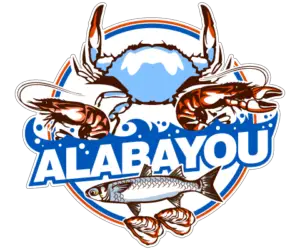In my travels performing seafood catering events across the country, I often get asked “what is saltwater fishing?” I often forget how blessed I was for growing up in Bayou La Batre, Al and being able to saltwater fish whenever I wanted to.
So just what is saltwater fishing? Saltwater fishing is the activity of catching fish that live in saltwater, such as oceans, seas, gulfs, bays, sounds, and saltwater lakes.
This type of fishing can be pursued by both recreational and commercial fishermen and is a popular pastime worldwide.
The term “saltwater fishing” encompasses a wide variety of techniques, gear, and species, and is a fascinating and rewarding pursuit for anglers of all levels.
In this article, we will explore the different types of saltwater fishing, the gear and equipment required, the various species of fish that can be caught, and the different techniques used to catch them.
Whether you are a seasoned angler or a beginner, this guide will provide you with a solid understanding of the basics of saltwater fishing.

Types of Saltwater Fishing
There are several types of saltwater fishing, each of which requires different gear and techniques. Here are the most common types of saltwater fishing:
Surf Fishing
Surf fishing is done from the shoreline or the beach, and it involves casting a line out into the surf to catch fish that are close to the shore.
It may come as a pleasant surprise to discover the diverse range of fish that you can catch from the shoreline, apart from the deep-sea game fish.

In fact, you can successfully reel in most saltwater fish without venturing too far into the ocean, making it an ideal starting point for beginners.
This type of fishing is best done during low tide, when the water is calm and the fish are closer to the shore. Surf fishing is typically done for species such as sharks, bluefish, and Pompano.
Recommend Surf Fishing Gear: For optimal saltwater surf fishing performance, it’s advisable to use a rod that measures between 12 and 15 feet in length and features generously-sized line guides.
Pair your rod with a sizable spinning reel that’s specifically designed for saltwater fishing, and spool it with a 20 to 25-pound test line to maximize your chances of success.
Recommended Surf Fishing Bait: If you’re looking for effective and straightforward bait options for saltwater surf fishing, consider using shrimp, mullet, or squid.
Shrimp, in particular, has a broad appeal and can attract many different types of fish. However, be aware that it can sometimes slip off the hook too easily.
Alternatively, if you prefer a bait that lasts longer but attracts fewer species of fish, mullet or squid can be good options to try out.
Pier Fishing
Pier fishing is done from a pier or a jetty, and it involves casting a line out into the water from a stationary position.
Pier fishing is popular because it allows anglers to fish in deeper water without needing a boat.
It is also a great option for beginners who are just starting out. Pier fishing is typically done for species such as redfish, Black drum, and snook.
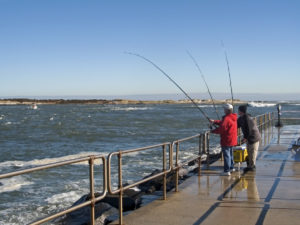
Recommended Pier Fishing Gear: To ensure a productive pier fishing experience, it’s recommended to have the appropriate saltwater gear.
A spinning fishing rod of medium or heavy-action that measures between 6 to 9 feet in length is ideal. For general usage, a 20-pound test line should suffice.
It’s important to bring a landing net or pier gaff to aid in pulling up your catch as attempting to reel it up without assistance may prove challenging and result in the loss of the fish, along with the potential risk of breaking your line.
Recommended Pier Fishing Bait: When it comes to bait for saltwater pier fishing, live and fresh bait tends to be highly effective. It’s recommended to bring an ample supply of blood worms, shrimp, and squid.
If you have a particular species of fish in mind that you’re hoping to catch, it’s advisable to seek advice from local anglers to determine the most suitable bait based on their experience and knowledge.
Inshore Fishing
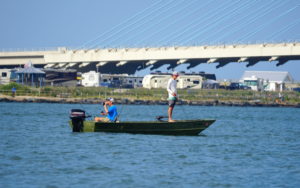
Inshore fishing is done in the shallow waters near the shore, typically in bays, estuaries, and flats.
This type of fishing is best done with a small boat or kayak, as it allows anglers to get into the shallow water where the fish are.
Inshore fishing is typically done for species such as redfish, speckled trout, flounder and mullet- my favorite fish.
Recommended Inshore Fishing Gear: For optimal results when inshore fishing, it’s advised to use a7-foot heavy-action rod in combination with a spinning or baitcasting reel.
To complete the setup, a 15-pound monofilament line should be added, ensuring that you’re fully prepared to begin fishing
Recommended Inshore Bait: When inshore fishing, it’s recommended to bring a mix of live and artificial bait.
For artificial bait, gold metal spoons and D.O.A. artificial shrimp with a popping cork are suggested.
Additionally, it’s advisable to bring live bait such as shrimp to experiment with and determine what the fish are most responsive to.
Offshore fishing or often called Deep Sea Fishing is done in deep water, typically several miles from the shore. This type of fishing requires a larger boat and specialized gear, such as deep sea fishing rods, reels, and lines.
Offshore fishing is typically done for species such as marlin, tuna,swordfish, snapper, and grouper.
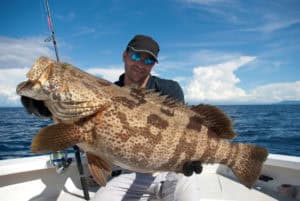
Recommended Offshore Fishing Gear: For off shore fishing, you can expect to encounter a diverse range of game fish, so it’s recommended to bring multiple rods tailored to the type of fish you wish to catch.
Generally, a 6 to 7-foot medium-action offshore fishing rod, equipped with a heavy conventional reel and 50-pound test fluorocarbon line, should suffice.
To target larger species such as grouper or amberjack, it is recommended to use fluorocarbon leaders with a minimum strength of 80 pounds, and possibly as heavy as 100 pounds.
However, for goliath grouper specifically, it is advised to use even stronger leaders with a test strength ranging from 180 to 220 pounds.
Recommended Offshore Fishing Bait: To increase your chances of catching game fish during off shore fishing, it’s recommended to experiment with a variety of live and artificial baits suited for bottom fishing and jigging.
Cut squid, thread fin herring, deep diving plugs, and deep-sea bottom jigs are all viable options.
As catching off shore game fish is highly dependent on skill and familiarity with the fishing technique, it’s important to try out different baits and determine what works best for you.
Gear and Equipment
The gear and equipment needed for saltwater fishing can vary depending on the type of fishing being done and the species of fish being targeted.
Here are the most common pieces of gear and equipment used in saltwater fishing:
Rods and Reels

Fishing rods and reels are the most important pieces of gear in saltwater fishing. The rod is used to cast the line, and the reel is used to retrieve the line and reel in the fish.
Saltwater fishing rods and reels are typically larger and more robust than freshwater fishing gear, as they need to be able to handle larger fish and rougher conditions.
When it comes to selecting a saltwater rod and reel, the decision will largely depend on the type of fishing you intend to do – whether you plan to bait cast, troll, or use metal jigs – as well as your intended catch and fishing location.
Here are some general tips to consider: Opt for a longer rod if you’re looking to cast further, while shorter rods provide more power when fighting fish.
The term “power” on a rod refers to its capacity for lifting weight. High-speed reels are better suited for fast baits, while low-speed reels offer more power when fighting fish.
Match the reel to the line weight of your rod. Select a rod based on the lure weight that corresponds to the size of the saltwater bait or lure you plan to use.

Lines and Leaders
Fishing lines and leaders are used to connect the fishing lure or bait to the fishing rod and reel.
Saltwater fishing lines and leaders are typically stronger and more durable than freshwater lines, as they need to be able to handle the larger fish and rougher conditions found in saltwater environments.
Lures and Baits
Lures and baits are used to attract fish to the fishing line. There are many different types of lures and baits used in saltwater fishing, including jigs, spoons, plugs, and live or dead bait. The type of lure or bait used will depend on the species of fish being targeted.
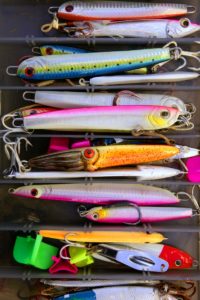
Terminal Tackle
Terminal tackle refers to the components used to connect the fishing line to the lure or bait. This includes items such as hooks, swivels, snaps, and weights.
Saltwater terminal tackle needs to be corrosion-resistant, as the saltwater environment can cause damage to the gear over time.
Fishing Tools Accessories
In addition to the basic gear and equipment, there are several accessories that can make saltwater fishing more enjoyable and productive.
These include items such as pliers, scissors, fish grips, and tackle boxes.
If you’re heading out for a saltwater fishing trip, there are four essential tools you should always bring along:
- Saltwater Gaffs and Nets: These are useful for landing your catch, as well as for practicing catch-and-release fishing in a safe and efficient manner.
- Saltwater Pliers and Scissors: These tools can be used to cut wire, remove hooks, and tighten knots. It’s important to learn how to tie proper saltwater fishing knots to increase your chances of success.
- Saltwater Fishing Knives: These knives are necessary for cutting bait and cleaning your catch once you’ve reeled it in.
- Saltwater Hook Remover: This tool helps to make hook removal quicker and safer, which is important for both you and the fish.
These accessories and tools can help anglers to quickly and safely handle their catch and keep their gear organized and easily accessible.
Saltwater Fishing Apparel
In order to stay safe and comfortable while saltwater fishing, it’s important to wear the appropriate clothing and gear. Here are some essential items to consider:
- Foul-Weather Gear: This includes boots and a rain jacket to keep you clean and dry in wet conditions.
- Breathable Saltwater Waders: When the water is 65 degrees or warmer, it’s important to wear breathable waders to keep you comfortable. For colder waters, neoprene waders are necessary to keep you warm.
- Sun Protection: Protect yourself from the sun with sunscreen, a comfortable long-sleeved shirt, and long pants. In addition, polarized sunglasses are essential to protect your eyes from the sun’s rays and make it easier to see into the water.
- Mesh Ball Cap: A mesh ball cap can help keep you cool by allowing air to circulate around your head, while also providing shade for your face.
- Cold-Weather Gear: When fishing in colder temperatures, it’s important to wear waterproof and windproof gear, such as a hat and top layer of clothing. Neoprene gloves are also essential to keep your hands warm and dry.
Sport your love for delicious seafood and show off your unique style with our ‘eat more mullet‘ mesh ball cap – it’s the perfect accessory for any seafood enthusiast!

Species of Saltwater Fish
There are hundreds of species of fish that can be caught in saltwater environments, each with its own unique characteristics and behaviors.
Saltwater fish can be cooked in a variety of ways such as grilling, baking, broiling, steaming, and frying. Each method brings out unique flavors and textures of the fish, making it a versatile ingredient in the kitchen.
If you’re a fan of fried fish or looking to explore new ways to cook your favorite seafood, check out our post on How to Fry Fish!
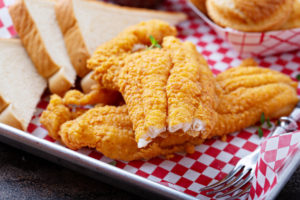
It’s packed with helpful tips and tricks to help you achieve perfectly crispy and delicious fish every time.
Here are some of the most common species of saltwater fish:
- Striped bass are a popular game fish found along the Atlantic coast of North America. They are known for their powerful fighting abilities and can be caught using a variety of techniques, including surf fishing, pier fishing, and boat fishing.
- Redfish, also known as red drum, are a popular game fish found in the Gulf of Mexico and along the southeastern coast of the United States. They are known for their bronze-colored bodies and are typically caught using live or dead bait.
- Tuna are a popular game fish found in deep water offshore. There are several species of tuna, including bluefin, yellowfin, and albacore. They are known for their speed and strength and are typically caught using trolling techniques.
- Marlin are a large and powerful game fish found in deep water offshore. They are known for their long bills and can be caught using trolling techniques or by baiting them with live bait.
- Tarpon are a popular game fish found in warm saltwater environments, such as Florida and the Caribbean. They are known for their acrobatic jumps and can be caught using a variety of techniques, including live bait and artificial lures.
If you’re a seafood lover or interested in saltwater fishing, don’t miss out on exploring my blog post about the 21 Best Fish to Eat from the Gulf Coast!
Techniques for Saltwater Fishing
There are many different techniques used in saltwater fishing, each of which requires a different approach and set of skills. Here are some of the most common techniques for saltwater fishing:
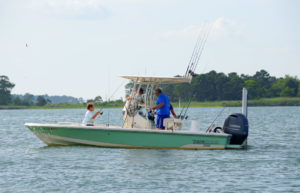
Casting
Casting is the most basic technique in fishing, and it involves throwing the lure or bait out into the water using the fishing rod and reel.
This technique can be used in a variety of saltwater fishing environments, including surf fishing, pier fishing, and inshore fishing.
Trolling
Trolling involves dragging a fishing lure or bait behind a moving boat. This technique is commonly used in offshore fishing to target large game fish such as tuna and marlin.

Bottom Fishing
Bottom fishing involves dropping the fishing lure or bait to the bottom of the water and waiting for the fish to bite.
This technique is commonly used in offshore fishing to target species such as grouper and snapper.

Fly Fishing
Fly fishing involves using a specialized fly rod and reel to cast a lightweight artificial lure made of feathers and other materials.
This technique is commonly used in saltwater environments to target species such as bone fish and tarpon.
Gill Netting

Gill netting is a widely used commercial fishing technique that is effective for targeting specific species of fish such as mullet, salmon, and herring.
The net is set perpendicular to the current, allowing fish to swim into the net and become entangled in the mesh.
When used responsibly and in accordance with regulations, gill nets can be an effective and sustainable tool for commercial fishing.
My family has been commercial gill net fishing for mullet for over 100 years on Alabama’s gulf coast.
Cast Netting
Cast netting is a technique used for catching small bait fish and also large mullet. The net is thrown out over the water in a circular motion, allowing it to sink and trap the fish.
This method is commonly used in inshore fishing and is popular among recreational fishermen as well as commercial fishermen.

Essential Bait for Saltwater Fishing
The choice of saltwater fishing bait depends largely on the feeding habits of the fish you are trying to catch.
To attract fish, you should consider the scent, sound, and movement of the bait.
By taking these factors into account, you can determine the most effective type of bait to use and entice the fish to bite your line.
Once you have identified the right bait, you should also consider whether to use live or artificial bait, depending on your fishing location and preferences.
Live or Fresh Saltwater Fishing Bait
- Bait Fish
- Crabs
- Clams
- Mussels
- Shrimp
- Squid
Artificial Saltwater bait
- Lead-Headed Jigs mimicking live saltwater bait.
- Metal Jigs for bouncing on the ocean floor.
- Poppers creating splashes on the water’s surface.
- Plug Fishing Lures to replicate swimming fish.
- Spoon Fishing Lures flashing and moving like swimming fish.
- Spinner baits tricking fish with sound and movement.
- Soft Plastic Lures offering flexibility in use.
Seek Advice From Experienced Fishermen in the area.

Local anglers have a wealth of knowledge and experience when it comes to saltwater fishing, and they can often provide more valuable insights than a general guidebook.
Once you have chosen your fishing location and target species, seek out other fishermen in the area at bait and tackle shops, on the shore, or on the pier.
Ask them about the techniques and baits they use to achieve successful strikes.
Keep in mind that each fisherman has their own preferences, and what works on one day may not work on another, so don’t be afraid to experiment with different approaches.
Conclusion
Saltwater fishing is a popular pastime enjoyed by millions of people around the world. Whether you are a seasoned angler or a beginner, there are many different types of saltwater fishing to explore, from surf fishing to offshore fishing.
The gear and equipment required can vary depending on the type of fishing being done and the species of fish being targeted, but there are some basic pieces of gear that every angler should have.
With the right gear and techniques, saltwater fishing can be a rewarding and exciting experience that offers the opportunity to catch a wide variety of fish and explore the beauty of the ocean.
However, it is important to remember that saltwater fishing also comes with some risks and responsibilities.
Anglers should always follow local fishing regulations and guidelines, practice catch-and-release when appropriate, and be mindful of the impact their fishing activities may have on the environment.
By doing so, we can ensure that saltwater fishing remains a sustainable and enjoyable activity for generations to come.
